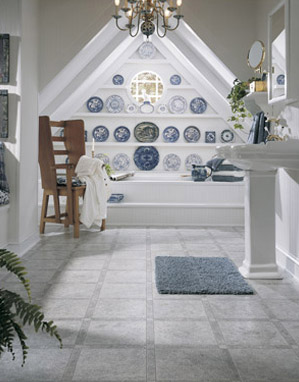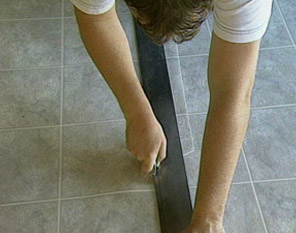Vinyl Installation
What to know before the installers arrive.
If you’re like many shoppers, you can just picture your new vinyl flooring, all beautifully installed, clean and promising – an inviting new stage upon which life in your home will now unfold.
Well, don’t lose that picture but do be prepared.
Being prepared and involved will help insure that the installation process is done smoothly and efficiently, and, hopefully, eliminate expressions of “I wish I’d known that.”.
Knowing what to expect will be a lot less stressful on you, your family and your home.
To that point, we’ve built this section around many of the things you should be aware of, plan ahead about, and carefully consider before your new vinyl flooring arrives.
Our first tip is about who should do the installation.
Now, you may be wondering if you could install your vinyl floor. Well, allow us to answer that right up front.
That way you can be assured of a beautiful, efficient and correct installation.
However, while installing vinyl flooring is a skill that is developed through years of experience, your understanding of the basics of installation will increase your knowledge of the process, and enhance your confidence in the professionals working in your home.
To begin, the installers get to the bottom of things.
As with most flooring products, the first step is to prepare the substrate, the surface on which the vinyl flooring will be laid.
If installing over a wood substrate, an underlayment will generally be necessary.
Installing over a concrete substrate will not require an underlayment but will require some floor preparation.
You will need to give attention to the height of your appliances to counters and cabinets if an underlayment is required.
Moisture testing for installations over concrete is required by manufacturers, so please understand that if your installers perform that task.
Can you install new vinyl flooring over existing vinyl flooring?
In some cases, yes. This is where employing qualified flooring professionals really pays off.
They can determine if your existing vinyl flooring is acceptable or if it will need to be removed.
Three methods are used to install vinyl flooring depending on manufacturer and style: Full Spread, Perimeter Adhered or Floating.
Full Spread means the adhesive is trowled over the entire substrate.
Perimeter Adhered is an installation method in which adhesive is only applied to the perimeter of the flooring and also at the seams.
Floating is a type of installation in which the vinyl flooring is not bonded to the substrate by any adhesive.
Your beautiful new vinyl floor will be professionally installed using one of those three methods.
What to know and do before installation day
Your furniture is priority one.
Remove all furniture and other objects and materials from the areas where the installation will take place. Some installers will move your furniture, but there may be an additional charge for doing so.
Before moving, you’ll also need to empty the contents of china cabinets, closets and the like.
Be aware that the area of installation must be climate controlled (heated or air conditioned). Indoor humidity should be maintained between 45-65%.
Make a decision on your old floor covering.
Please consider how your old floor covering will be taken up and disposed of. This can be a time consuming task. We recommend that you check with us about the cost and the method of disposal.
If you prefer to remove your present floor covering, do it at least one day prior to arrival of your vinyl product to allow for cleanup and floor preparation. If removing old carpet, please leave tack strips in place and pull the staples out of the floor from the original pad.
What’s to be done with the trim?
In many cases, moldings and baseboards need to be removed for vinyl installation. Your installer may do this but at an additional charge and they will probably not be responsible for damage or breakage due to dry or brittle wood.
Painted baseboards, woodwork and paint may need retouching after the installation is complete. If necessary, this is your responsibility.
Next area is the subflooring.
Your existing subfloor may need to be prepared to receive the vinyl, or a new subfloor may be required. We suggest you discuss this with us and, if subfloor work is necessary, that it be done by qualified professionals. It is important that the subfloor be as clean and level as possible.
Get in the know about the clean-up.
Installing new vinyl will produce waste. Usually these materials are collected by your installer and left at your trash collection site. Check with us before the day of installation so you’re clear about the clean up, if there are added costs to do so, and ask about the plan for vinyl remnants.
What to know and do during installation day
Be home on the big day.
Be prepared to be at home the day of installation and be available in case the installation crew has questions. Your presence will insure that the correct vinyl is installed in the right areas. Because it is difficult to estimate the length and circumstances of each job, some installers may not be able to give you an exact time of arrival. We suggest you be flexible and keep in touch with us.
Keep safety top of mind.
Your installers will use a variety of tools and techniques that can make the work area hazardous. Please make sure that your children and pets are kept out of the work area on installation day.
Walk through and ask questions.
We recommend that, prior to the completion of the installation, you walk through the job with the chief installer. This will give you the opportunity to ask questions and be clear on any final details.
What to know and do after installation day
Time and temp are key.
For a minimum of 24 hours after your new vinyl floor is installed, protect all the seamed areas, don't walk on them or the seam sealer.
Keep the room at 68° F or greater for at least 2 days after installation to allow the adhesives to setup properly.
If you are sensitive to dust and odors, good ventilation should be established for 48 to 72 hours after installation.
If your vinyl floor was installed using the Full Spread method, no appliances should be moved in for a minimum of 24-72 hours after installation. Light foot traffic is allowed after 24 hours.
If the Perimeter Adhered installation method was utilized, no appliances should be moved in for a minimum of 24-72 hours after installation. Light foot traffic is allowed after 24 hours.
If the installers used the Floating method, appliances can be moved in immediately and foot traffic is OK immediately following installation.
When you are ready to move appliances back into the room, an underlayment type of product such as plywood or particleboard with a minimum thickness of 3/8,” placed on the new flooring prior to moving the appliances, will greatly reduce any mishaps.
Do not rely on the wheels that may be attached to the refrigerator to move the appliance back in as they can cause damage to the new floor.
Allow 5 days before thoroughly washing your floor. This will give time for the adhesive to cure.
When it comes to preparing for your vinyl flooring installation, we want you to know. Know all about those things that will make the installation as smooth and efficient as possible. So that the picture of the vinyl flooring you have in your mind today will come true, and stay true for many years.



